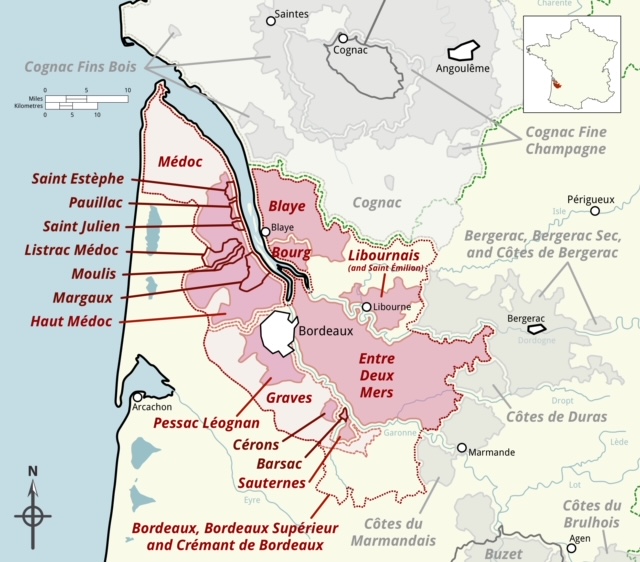Château Lynch-Moussas is located on a very fine gravelly hilltop next to the hamlet of Artigues and Château Grand Puy and Château Batailley in Pauillac. When the official classification of Médoc wines appeared in 1855, it was classified as a Fifth Growth.
The Château’s history goes back to 1610, when Domaine de Moussas-Bages belonged to the Jehan family, who were wine merchants and owners of several estates. In 1728, Domaine de Moussas-Bages was purchased by the Drouillard family.
In 1748, Thomas Lynch inherited the Domaine through his wife, Elisabeth Drouillard, and renamed it Château Lynch. In 1779, Jean-Baptiste Lynch, who was the mayor of Bordeaux in 1808, a Count of the Empire in 1811, and then Peer of France in 1815, inherited the Château and entrusted its management to his brother, Michel Lynch, a knight and the mayor of Pauillac. When Jean-Baptiste Lynch died in 1835, Château Lynch was split into two estates. Château Lynch-Moussas (located at the place named Moussas) and Lynch-Bages (located at the place named Bages) thus came into existence. Château Lynch-Moussas kept the château building.
In 1847, Château Lynch-Moussas was purchased by the Vasquez, a Spanish wine merchant family. Subsequently, in 1855, Château Lynch-Moussas was classified as a 5th Grand Cru Classé du Médoc. The official 1855 classification of the wines of Bordeaux, organised by the Bordeaux Chamber of Commerce, was set up on the occasion of the Paris Universal Exhibition at the request of Napoléon III. This classification only comprised the wines of the left bank of the river and included a “Vin Supérieur de Sauternes”, Château d’Yquem, and a Pessac-Léognan, Château Haut Brion. This classification continues to prove a guarantee of high quality to this day.
In 1919, Jean Castéja, the owner of Château Duhart-Milon (a 4th Grand Cru Classé in Pauillac), Château Pichon-Longueville Baron (a 2nd Grand Cru Classé in Pauillac), and Château Doisy-Védrines (a 2nd Grand Cru Classé in Sauternes and Barsac), added Château Lynch-Moussas to the family estates. At that time, the property covered over 250 hectares, 120 of which were made up of vines, woodland and pastureland. At the end of the 1960s, Jean Castéja’s sons (Pierre, Émile, Jean, and Édouard Castéja) decided to divide up the family’s assets.
In 1970, Émile Castéja (the husband of Denise Borie and father of Chantal Preben Hansen and Philippe Castéja) took over the reins of the Château, undertaking numerous works to overhaul the property. From a surface area that had fallen to less than ten hectares, Émile Castéja replanted the entirety of the vineyard and increased its size to 60 hectares. He modernised the Château, restoring this magnificent manor house to its former glory, and renovated the cellars to equip them with better winemaking facilities. The Château now gained renown for the high quality of its wines.
In the 2000s, Philippe Castéja took over the estate, adding impetus to the estate’s development and modernisation, and brought in Denis Dubourdieu and his team as wine consultants. For the 2001 vintage, Émile and Philippe Castéja launched the estate’s Second Wine, “Les Hauts de Lynch-Moussas”, produced from the estate’s youngest plots. On 21st June 2019, the Castéja family celebrated 100 years of having owned and run Château Lynch-Moussas. To mark the occasion, the Castéja family organised the 2019 Fête de la Fleur at Château Lynch-Moussas.
Located close to the Gironde estuary on its eastern side, and with the Atlantic Ocean to its west; between the appellations of Saint-Estèphe to the north and Saint-Julien to the south, the Pauillac vineyard benefits from an oceanic climate. These surrounding masses of waters make it a particularly favourable climate for wine-growing. The Pauillac wine appellation or AOC (Appellation d’Origine Contrôlée) was officially recognised in 1936 and is today made up of around 40 wine estates, 18 of which are Grands Crus Classés belonging to the 1855 classification, making it a world-renowned terroir. The geology of the Pauillac commune features an extension of gravelly terraces that lie parallel to the Gironde estuary. These terraces, which date back to the Quaternary era and have a depth of around ten metres on average, cover a subsoil of marl and limestone dating from the Eocene and Oligocene eras. The main Pauillac grape varieties are Cabernet Sauvignon, Merlot, Petit Verdot, Cabernet Franc and Carménère.
With a vineyard covering 62 hectares (153 acres) in the heart of the Pauillac appellation, Château Lynch-Moussas produces grapes of the finest quality. The vines, planted on gravelly outcrops dating from the Günz era, made up of pebbles and gravel cemented together by clay sands, are tended with the greatest care and attention to allow them to express the full richness of their terroir. The Château Lynch-Moussas vineyard, made up mostly of Cabernet Sauvignon (75 %) together with Merlot (25 %) is adjacent to plots belonging to a certain number of other Grands Crus Classés, such as Château Latour, Château Lynch-Bages, Château Pichon-Longueville Baron, Château Grand-Puy-Lacoste and of course Château Batailley, which amply demonstrates the quality of the estate’s soils and its production.
New oak through spiced blackcurrant & stoney flinty gravel minerals w/ soft red fruits, crushed pencil, herbs, smoke & light mocha. Med body of smooth mocha & liquorice infused blackcurrant w/ a dry mineral silky fine tannin backbone. Med minerally blackcurrant soft finish w/ a mocha liquorice tingle
Awards:
92 Jeff Leve, The Wine Cellar Insider
92 Wine Enthusiast
92-94 Wine Advocate-Parker
90 Wine Spectator
88 Tim Atkin
VIVINO 4.2



